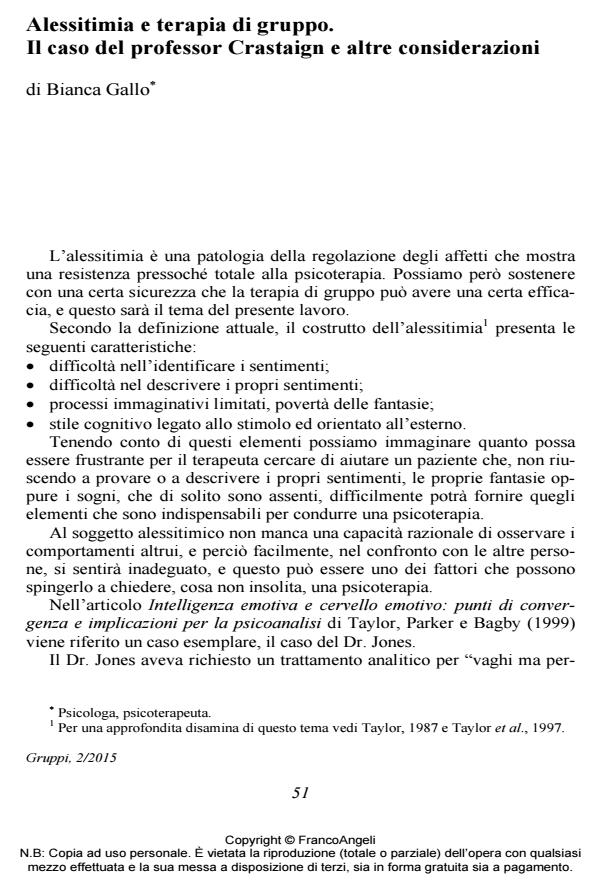Alexithymia and group therapy: the case of professor Crastaign and other remarks
Journal title GRUPPI
Author/s Bianca Gallo
Publishing Year 2016 Issue 2015/2 Language Italian
Pages 10 P. 51-60 File size 84 KB
DOI 10.3280/GRU2015-002005
DOI is like a bar code for intellectual property: to have more infomation
click here
Below, you can see the article first page
If you want to buy this article in PDF format, you can do it, following the instructions to buy download credits

FrancoAngeli is member of Publishers International Linking Association, Inc (PILA), a not-for-profit association which run the CrossRef service enabling links to and from online scholarly content.
Alexithymia is a disorder of affection-regulation. In tackling this theme, the author present a literary and a clinical case which show that group psychotherapy, as opposed to the individual psychotherapy, can produce positive effects. Indeed group-therapy can allow alexithyimia sufferers to re-build mental functions not yet fully developed, through group specific phenomena. As mental functions have a neural correlate, the author examines the possible causes of this malfunctioning, both through the recent acquisitions of neuroscience and by referring to the theories of Bion and other authors.
Keywords: Alexithymia, group therapy, affection regulation, emotions, alpha function, mirroring.
- Bion W.R. (1962). A Theory of Thinking. In: Second Thoughts. London: William Heinemann, 1967 (trad. it.: Una teoria del pensiero. In: Analisi degli schizofrenici e metodo psicoanalitico. Roma: Armando, 1970).
- Damasio A. (1999). The Feeling of What Happens: Body and Emotion in the Making of Consciousness. New York: Harcourt (trad. it.: Emozione e coscienza. Milano: Adelphi, 2000).
- Fonagy P., Gergely G., Jurist E.L., Target M. (2000). Regolazione affettiva, mentalizzazione e sviluppo del sé. Milano: Raffaello Cortina, 2005.
- Gallese V., Migone P., Eagle M.N. (2006). La simulazione incarnata: i neuroni specchio, le basi neurofisiologiche dell’intersoggettività ed alcune implicazioni per la psicoanalisi. Psicoterapia e Scienze Umane, 3: 543-580.
- Iacoboni M. (2008). I neuroni specchio. Milano: Raffaello Cortina.
- Iacoboni M., Molnar-Szakacs I., Gallese V., Buccino G., Mazziotta J.C., Rizzolatti G. (2005). Grasping the Intentions of Others with One’s Own Mirror Neuron System. PLoS Biology, 3, 3, e 79: 529-535. --Testo disponibile al sito: www.plosbiology.org Lorito L., Di Maria F. (2015). Gruppoanalisi e teoria dell’attaccamento. Bologna: il Mulino.
- McDougall J. (1989). Teatri del corpo. Milano: Raffaello Cortina.
- Neri C. (2004). Introduzione al Social Dreaming e resoconto di due workshop tenuti a Raissa e Clarice Town. In: Lawrence G., a cura di, Esperienze nel Social Dreaming. Roma: Borla.
- Panksepp J. (1998). Affective Neuroscience: The Foundations of Human and Animal Emotions. Oxford: Oxford University Press.
- Pennac D. (1997). Signori bambini. Milano: Feltrinelli, 2003.
- Rizzolatti G., Sinigaglia C. (2006). So quel che fai. Il cervello che agisce e i neuroni specchio. Milano: Raffaello Cortina.
- Solano L. (2001). Tra mente e corpo. Come si costruisce la salute. Milano: Raffaello Cortina.
- Solms M. (2015). The Feeling Brain. London: Karnak.
- Solms M. e Turnbull O. (2002). Il cervello e il mondo interno. Introduzione alle neuroscienze dell’esperienza soggettiva. Milano: Raffaello Cortina, 2004.
- Stora J.B. (1999). Quand le corps prend la relève. Stress, traumatisme et maladies somatiques. Paris: Odile Jacob.
- Taylor G.J., Bagby R.M., Parker J.D.A. (1997). I disturbi della regolazione affettiva. Roma: Giovanni Fioriti, 2000.
- Taylor G.J., Parker J.D.A., Bagby R.M. (1999). Intelligenza emotiva e cervello emotivo: punti di convergenza e implicazioni per la psicoanalisi. Journal of the American Academy of Psychoanalysis, 27, 3: 339-354 (trad. it. e intr. di Porcelli P., --disponibile sul sito Psychomedia: http://www.psychomedia.it/pm/answer/psychosoma/taylor.htm 58.0 k).
- http://www.psychomedia.it/pm/answer/psychosoma/taylor.htm 58.0 k).
- Taylor G.J. (1987). Medicina psicosomatica e psicoanalisi contemporanea. Roma: Astrolabio, 1993.
- Winnicott D.W. (1968). Una connessione tra pediatria e psicologia infantile: osservazioni cliniche. In: Bambini. Milano: Raffaello Cortina, 1997.
- Winnicott D.W. (1971). Gioco e realtà. Roma: Armando, 1974.
Bianca Gallo, Alessitimia e terapia di gruppo. Il caso del professor Crastaign e altre considerazioni in "GRUPPI" 2/2015, pp 51-60, DOI: 10.3280/GRU2015-002005